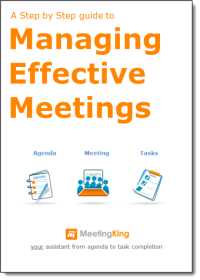Meeting action items (or tasks) are the driving force of any business, organization, institution, or club. They help you reach your goals. For this reason, writing and managing action items properly is essential.
We created a list of 5 best practices and tips to make you the king (or queen) of task management!
1. Record the Action Item
Talking about the task is not enough, you should write it down. The key to an effective meeting action item (or any task for that matter) is being clear, brief, and leaving no room for interpretation. For example, if you write “project presentation”, it does not tell the person what should be done with the presentation. However, if your note reads “add selected product shots to the project presentation slides”, there is no ambiguity there.
You should also add any other relevant information that is required to complete the task. For instance, a colleague’s contact details or links to reference materials. Having all these elements in place makes your workflow more efficient and prevents back and forth among team members.
2. Explain the Objective
It is good practice to explain the reason behind the task and to include the objectives in the meeting minutes. When your team members understand why completing their meeting action items is important and how they contribute to the overall goals, it improves their motivation.
Clearly outlining objectives in the meeting minutes also ensures that everyone is on the same page and working towards the same goals. This also serves as a reminder of why certain tasks were assigned and what needs to be accomplished to achieve the desired outcome.
3. Define the Deadline
When do you need the action item to be completed? The deadline that you set should be realistic. You should take into account the task owner’s current assignments as well as potential hurdles that may emerge.
Be firm when stating the deadline for action items so that you do not end up in a situation where people miss deadlines because they assumed they would have more time. To further prevent delays, it can be helpful to follow up with task owners periodically to check on their progress and address any potential roadblocks that may impact their ability to meet the deadline.
4. Assign Tasks
It is crucial to delegate a person for every meeting action item. Assigning tasks serves a few purposes. Your team members are clear on who is responsible for what and who to go to if they have a question about a specific task. Most importantly, you can keep people accountable and prevent shifting blame.
5. Determine the Next Steps
The last phase in the process is clearly determining the next steps and monitoring the progress. For things to go smoothly, team members responsible for action items should inform the person in charge when the task is completed. Likewise, if there are some changes to the requirement of the task, the person in charge should inform the team member responsible for it (in MeetingKing, such updates are automatically emailed to the task owner).
This part of meeting action items is very important because oftentimes tasks are related. One task needs to be finished before you can start working on the next one. A lot of time and unnecessary communication can be saved if you have an efficient process in place.
Bonus Tip
Streamline the process by organizing and keeping all meeting action items in one place. You can avoid a lot of frustration trying to find action items if they are always recorded and stored in the same place. Additionally, if tasks are organized by due dates and people they were assigned to, it will be easier to track them.
Digital meeting management tools like MeetingKing can help with the whole process. In our software, you can easily write, assign tasks and define deadlines while writing meeting minutes. Each delegated person will get automatic reminders to complete their tasks. You can also effortlessly track action items in the dashboard eliminating the need to check up on their progress with team members.
In Summary
Managing action items might seem a time-consuming, complex, or even menial task! However, if action items are recorded clearly and in one place, your team is aware of their tasks and when they should be completed, the whole process can become more straightforward. Especially if you take advantage of digital meeting management tools.
Give MeetingKing a try with our Free 30-day trial and become the king or queen at managing action items.
__
The image above by Andreas on Freepik



